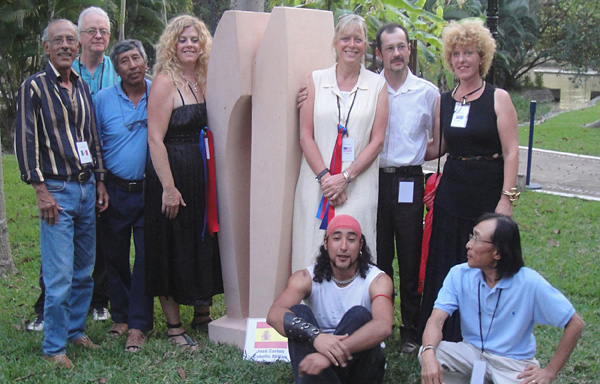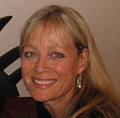
|  |  |  Vallarta Living | Art Talk Vallarta Living | Art Talk  
Truly Public Art: Sculptures Carved on the Malecón Now Grace Museum Grounds
 Carole Turner - PVNN Carole Turner - PVNN
March 10, 2010


| | The works of the 2010 Puerto Vallarta International Sculpture Symposium now grace the grounds of the Peter Gray Museum on the campus of the University of Guadalajara. |  |
Hundreds of Vallartans and visitors watched daily as blocks of stone were transformed into works of art during the Puerto Vallarta International Sculpture Symposium (PVISS) 2010 January 31 - February 13. The large scale sculptures were carved on the Malecon, under the sails where the Cuale River meets the sea. The Cuale Bridge provided an arena-like vantage point for the event - "Public Art" in the most literal sense.

| | For more information and sponsorship opportunities, please visit pviss.com or email pvissrocks(at)gmail.com. |  |
Drawn by word of mouth or the sounds of specialized tools and plumes of stone dust, fascinated viewers returned day after day to check on the progress. Some spent hours watching, many chatted with the sculptors and took photos, and most had the same questions: how do you do that, what exactly is a Sculpture Symposium, how did this symposium come about, how were the sculptors selected, what type of stone is that, where did you get such big blocks of it, what will happen to the sculptures, and will there be another PVISS?

Now the finished sculptures grace the grounds of the Peter Gray Museum on the campus of the University of Guadalajara. They look right at home among the lush greenery and water and the students have welcomed them with great interest... and the same questions.

How do you do that? For the most part, the sculptures were carved not with hand tools, as many would assume, but with time saving power tools - an assortment of angle grinders and diamond discs of varying sizes and types, pneumatic air hammers, electric and manual sanding tools, and drills. These tools, as used by experiences sculptors, save time and offer a surprising amount of control.

What exactly is a Sculpture Symposium? The first sculpture symposium was held in Austria in 1959 and they continue to occur, most commonly in Europe and Asia, throughout much of the world. The participating sculptors enjoy the opportunity to work on a much larger scale than normal, inspired by a new and interesting location, and revel in the cross cultural artistic synergy. Citizens of a hosting community benefit in the exposure to large scale sculpture as it is created, while becoming acquainted with the international artists and their techniques, and they continue to enjoy the sculptures after the artists depart.

How did this Symposium come about? The idea to host a symposium in Puerto Vallarta was born in Russia of all places. Invited to a sculpture symposium there is 2008, Dana O'Donnell and Carole Turner met as the only American sculptors. Carole was organizing a symposium in Oregon and Dana, a part time resident of Puerto Vallarta, thought it would be a great location for a symposium. During the next year, as economic events stalled their respective plans, they decided to combine resources and energies and jointly produce the First Puerto Vallarta International Sculpture Symposium in 2010.

How were the sculptors selected? At an International Sculpture Symposium there is usually a mix of old friends and new ones and this symposium is no different. Carole first met Won Lee (Korea/Canada) at a symposium in Vietnam and Jose Carlos Cabello Millan (Spain) at a symposium in Argentina and met Birgit Grapentin (Australia) related to the planned symposium in Oregon. Dana knows Tom Allan (Scotland) from a symposium in Scotland and Martin Distancia (Mexico) and Manuel Palos (Mexico/U.S.) through Palos Talleres de Arte in Puerto Vallarta. David Alejandro Martinez Bucio (Mexico City), is a new friend though AIESM, the Association of International Monumental Sculpture. Each symposium brings new international friendships and connections and, happily, for sculptors in monumental scale, it becomes a very small world.

What type of stone is that and where did you get such big blocks of it? The blocks of Cantera, a Mexican limestone, came from a quarry in Querétaro, where they were cut to order.

What will happen to the sculptures? The sculptures were moved to the grounds of the Peter Gray Museum for the final exhibition of symposium sculptures, as well as an exhibition of smaller sculptures by the international artists. Generous Museum patrons Fred and Dorothy Piontkowski, Diego and Mary Mora, Buri Gray, Jerry and Ann Lafferty, and Rosemary Gray and Jeremy Gray have purchased symposium sculptures and have donated them to the museum where they will continue to be enjoyed by students and the public.

Will there be another PVISS? Yes. Planning is underway for PVISS 2011. Much was learned from the first PVISS and with municipal and corporate sponsorship, PVISS 2011 will be bigger and better!

For more information and sponsorship opportunities, please visit pviss.com or email pvissrocks(at)gmail.com.
 
Carole Turner is a sculptor in bronze and stone, a frequent participant in international sculpture symposia, and co-organizer of the 2010 Puerto Vallarta International Sculpture Symposium. She is based in Oregon and enjoys spending as much time as possible in Puerto Vallarta, where her sculpture can be found at Galeria Uno. Visit her website at TurnerStudio.com |

 |
|  |



